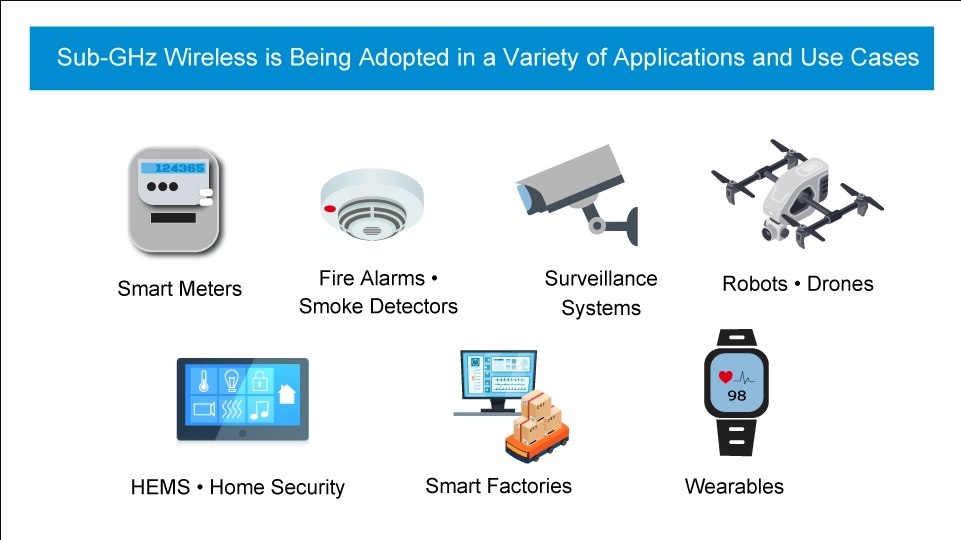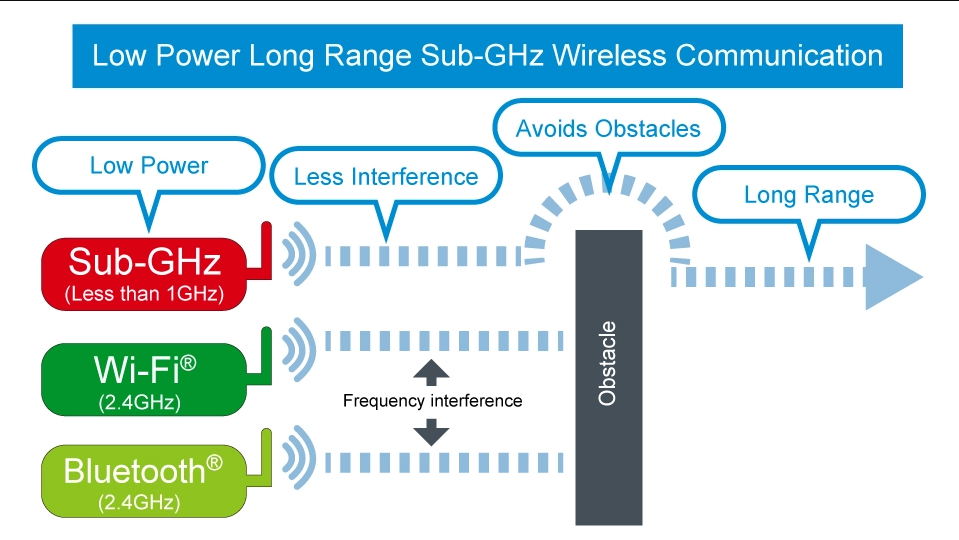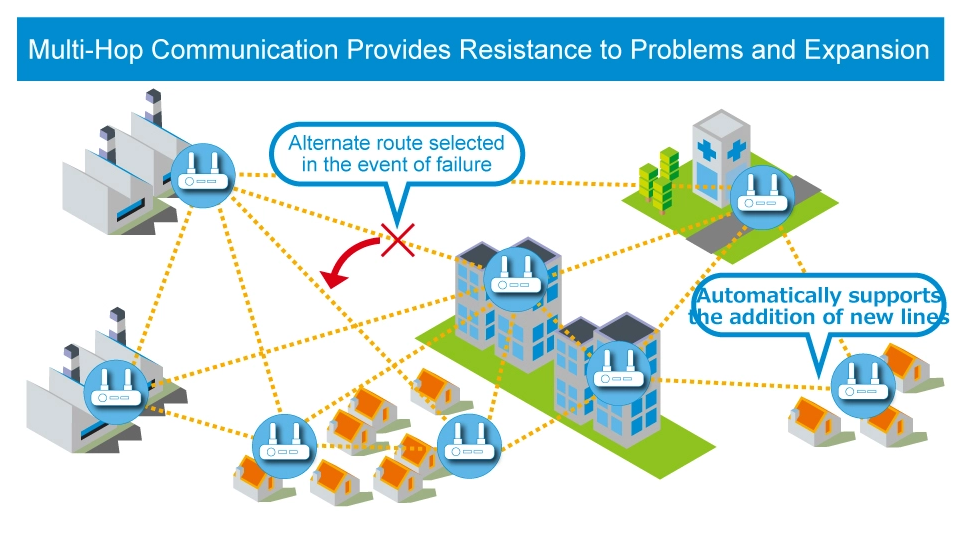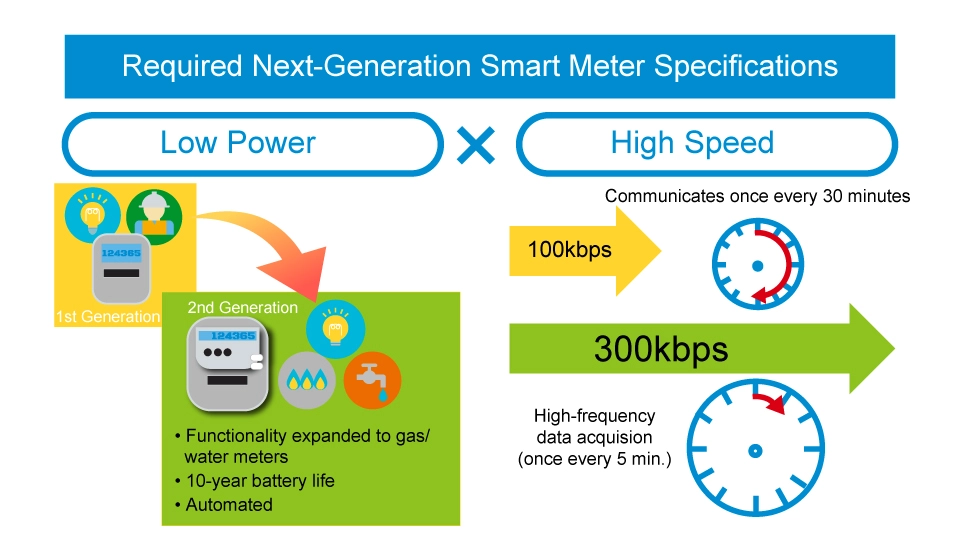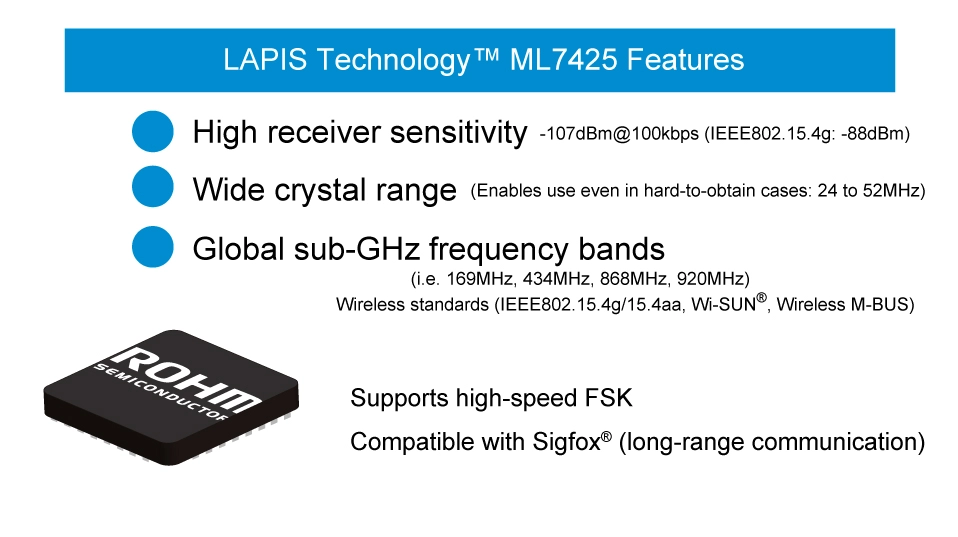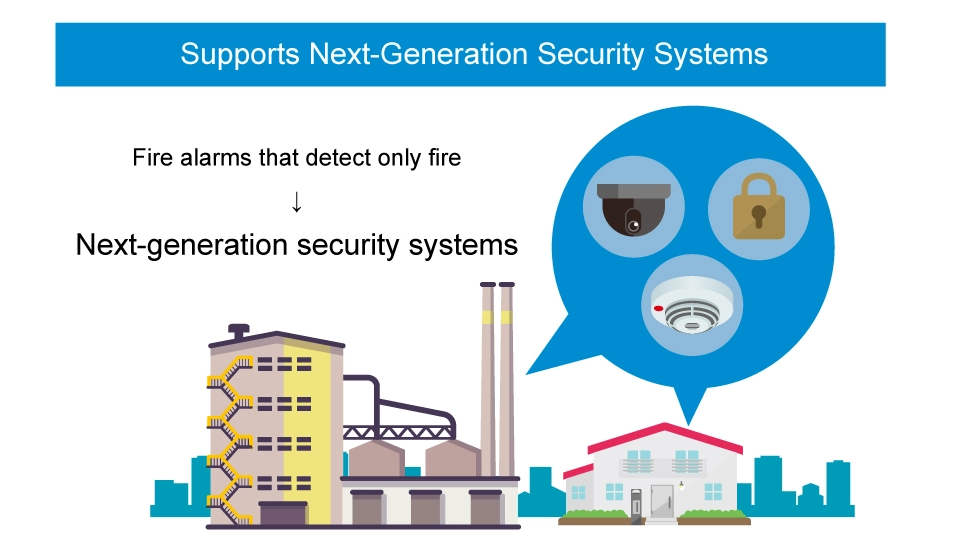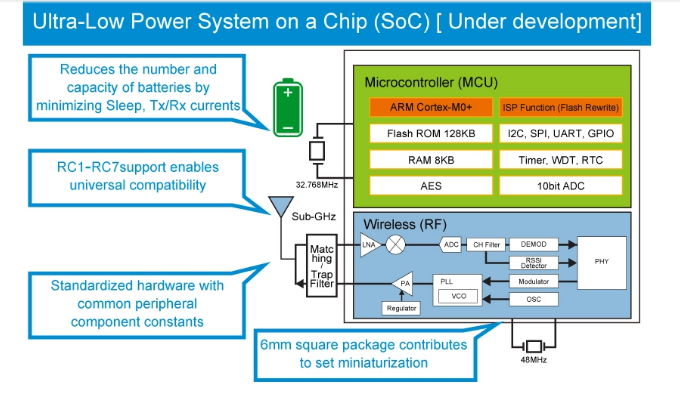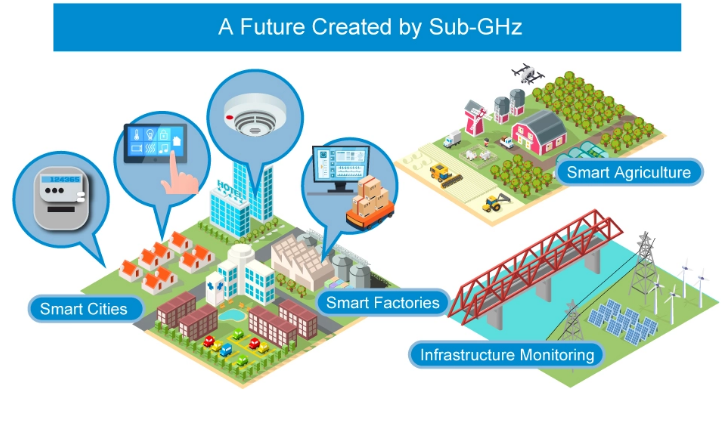Courtesy: RoHM
~ ROHM provides wireless communication ICs optimized for next-generation smart meters, security systems, and smart society ~
An increasing number of devices used in everyday life, such as smart meters, fire alarms, and security systems, are beginning to connect using a method called ‘Sub-GHz wireless communication’ (also known as the ‘sub-giga band’). In contrast to Wi-Fi or Bluetooth, Sub-GHz offers features such as long-range communication, low power consumption, superior resistance to obstacles, and support for multi-hop communication – making it a key technology that is attracting attention for achieving a smarter society through IoT.
Here, we will introduce the mechanism of Sub-GHz communication, compare it with other wireless technologies, introduce specific implementation examples, and explore the future society this technology will bring.
*Wi-Fi is a trademark or registered trademark of Wi-SUN Alliance.
*Bluetooth is a trademark or registered trademark of Bluetooth SIG.
1. Four Features of Sub-GHz Wireless Communication
Sub-GHz wireless communication refers to transmission technology utilizing frequencies below 1GHz. While not as widely recognized as Wi-Fi or Bluetooth, Sub-GHz is being increasingly adopted in a variety of applications that support our daily lives.
Sub-GHz is considered a key technology for achieving on IoT society due to 4 major features that surpass both conventional Wi-Fi and Bluetooth.
1. Long-distance communication
The first feature is the ability to communicate over long distances. The lower the frequency, the easier it is for radio waves to penetrate obstacles and the less susceptible to interference from walls and floors, making it advantageous for long-distance transmission. Sub-GHz wireless communication operates at frequencies below 1GHz, much lower than the 2.4GHz and 5GHz bands used for Wi-Fi and Bluetooth, respectively, making long-distance transmission possible over several tens of kilometers in line-of-sight conditions or several kilometers in urban areas.
2. Low power consumption
Another major advantage is low power consumption, since lower frequencies require less power for transmission. This makes sub-GHz particularly suitable for battery powered devices, providing several to dozens of times longer battery life than either Wi-Fi or Bluetooth.
3. Resistance to obstacles
The sub-GHz band ensures stable communication by allowing radio waves to bend around obstacles more easily and be less affected by walls and floors. This allows communication without interference from existing devices operating in the commonly used 2.4GHz band, such as Wi-Fi, Bluetooth, and even microwave ovens.
4. Supports multi-hop communication
The last major feature is support for multi-hop communication, in which transmission is carried out using repeaters. Multi-hop communication can further extend communication distance and enable transmission in hard-to-reach areas. This method is also becoming more popular due to lower installation costs (repeaters are cheaper to install than base stations) and greater resistance to disasters (communication is possible using repeaters even if a base station is damaged), expanding the use of sub-GHz wireless communication.
2. Sub-GHz Wireless Communication Standards
Various standards for Sub-GHz communication exist, each with different characteristics.
For example, Wi-SUN is recommended if high reliability, high-speed communication is required, Sigfox is ideal for extremely low power consumption, long distance communication, LoRaWAN is suitable for long-distance communication and flexible network configuration, and Zigbee is a good choice if short-distance communication with low power consumption is demanded.
*Wi-SUN is a trademark or registered trademark of Wi-SUN Alliance.
*Sigfox is a trademark or registered trademark of UNABIZ.
*LoRaWAN is a trademark or registered trademark of Semtech Corporation.
*Zigbee is a trademark or registered trademark of Connectivity Standards Alliance.
3. Issues with sub-GHz wireless communication
Sub-GHz wireless communication is a technology that holds great potential, but issues such as slower data transfer speeds compared to other protocols like Wi-Fi and Bluetooth and the available frequency bands that may vary by country make worldwide deployment difficult.
Overcoming these challenges is necessary to make sub-GHz communication more convenient and reliable. The technology continues to evolve as applications that use sub-GHz communication, such as smart meters and fire alarms, are due for replacement.
4. Opening Up the Future with Sub-GHz 1: Next-Generation Smart Meters
A typical application of sub-GHz communication is smart meters. Implementation will bring benefits to electric power companies by streamlining meter reading, appropriately adjusting electricity supply and demand, and optimizing power grid operation, while users will be able to save energy and reduce electricity bills by visualizing electricity usage.
Although smart meters offer convenience and superior performance, their lifespan is typically 10 years from start of operation. As such, in many countries the time to replace meters with next-generation smart meters is fast approaching.
What is required of next-generation smart meters is a combination of high-speed communication and low power consumption. As well as compliance with international standards. This is made possible using more advanced sub-GHz wireless ICs.
Among these, there is a growing interest in Sigfox, a wireless standard characterized by low cost, low power, long distance transmission, as a communication standard for next-generation smart meters.
Available in over 70 countries worldwide, Sigfox enables seamless, low-cost communication across borders, making it ideal for IoT applications that connect a large number of devices.
ROHM is expanding its lineup of sub-GHz ICs that support Sigfox.
For example, the ML7425 Sigfox-compatible sub-GHz wireless IC leveraging ROHM Group’s LAPIS Technology has been well received both in Japan and abroad for its excellent reception sensitivity characteristics and wide crystal selectivity range (XTAL/TCXO).
5. Opening Up the Future with Sub-GHz 2: Adapting to Evolving Security Systems
A wave of next-generation specifications is coming not only for smart meters, but also fire alarms and security systems, along with the need for replacement due to breakdowns or dead batteries. As fire alarms and security systems are directly related to human life, the demand for more advanced systems is growing and expected to continue to increase in the future.
Conventional fire alarms are limited to a single function, such as fire detection, while security systems only detect intrusion, making it difficult to link with other systems and share information. At the same time, there were issues such as susceptibility to false alarms caused by smoke or insects, along with high installation and operational costs.
Next-generation security systems are emerging that overcome these challenges. For example, some fire alarms combine sensors to detect not only smoke, but also carbon monoxide (CO), temperature, humidity, occupancy, and ambient light, as well as water leaks and glass breakage. In the latest integrated security systems, products are being released that can be installed without the need for electrical work and easily operated from a smartphone.
By linking with smart homes, these next-generation security systems expand the possibilities for safer, more advanced operations that can lead to significant reductions in damage while also providing features like AI-based false alarm prevention and cost reduction through IoT technology.
Again, the key components here are advanced sub-GHz wireless ICs. Switching from traditional wired to wireless solutions not only reduces power consumption by eliminating the need for wiring, but also requires the ability to acquire data quickly at high frequencies while maintaining stable communication.
What’s more, the sub-GHz IC ML7425 introduced earlier is equipped with a function that can process multiple wireless channels at high speed. This is particularly useful for applications that require rapid processing of communications between a parent unit and multiple child units, such as repeated transmission between a home gateway and various terminals (i.e. home appliances, window/door sensors) in a home security system. High-speed processing also reduces CPU load, resulting in lower system power consumption while allowing CPU resources to be quickly shifted to other processes.
What’s more, high-speed communication enables data transmission to be processed in a shorter time, reducing the total power consumption of the radio frequency (RF) and enabling the MCU that controls the radio to go to sleep earlier. This contributes to overall system power efficiency, leading to lower battery capacity, smaller size, lower cost, and longer life.
In response, ROHM is currently developing an ultra-low current wireless SoC (System on a Chip) that can meet various specifications worldwide across a wide range of bandwidths.
By providing the lowest current consumption on the market along with Sigfox Monarch compatibility (common peripheral parts, high output PA, RC1 to RC7 support) in the industry’s smallest package (6mm x 6mm), ROHM is targeting next-generation security systems, infrastructure monitoring, and other applications requiring battery operation.
6. Opening Up the Future with Sub-GHz 3: Developing a Smart Society
The use of sub-GHz wireless communication is not limited to just smart meters and security systems. Contributions to a variety of services are expected as a critical technology for achieving a smart society.
As an example, while sub-GHz wireless communication has already been adopted in smart cities, smart factories, smart logistics, and smart agriculture, the application scope is likely expand to various other sectors, including advanced monitoring for the elderly in conjunction with security systems, infrastructure monitoring, and disaster response.
7. Conclusion
Sub-GHz wireless communication is being used in a wide range of fields, beyond those mentioned here, from IoT and Machine to Machine (M2M) to wireless sensor networks. Going forward, ROHM will continue to develop a variety of sub-GHz communication ICs that meet market needs utilizing LAPIS Technology.








